Museums Doge's Palace | Guggenheim | Correr | Pesaro | Rezzonico | Murano | Accademia | Oriental | Ca d'Oro | Archeological | Querini | Bovolo | Pisani | Fortuny | Rocco | Lace | Marciana | Grassi | Dogana
San Rocco History Art | Location | Opening Hours Tickets | Authorizations
History Art Scuola | Rivalries | Crucifixion | Pilate Ecce Homo Calvary | Official Painter | Snake | Moses Manna | Sin Isaac Jacob | Adoration Temptation Breads | Probatic Pool Last Supper | Olive Garden Resurrection | Pianta | Annunciation Adoration Flight | Innocents Circumcision
Scuola Grande San Rocco in Venice “The Adoration of the Shepherds”
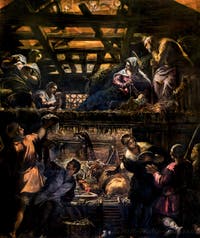
The Adoration of the Shepherds
Tintoretto “The Adoration of the Shepherds”
Oil on Canvas (542 x 455 cm) 1578-1581Behold, a stable and its hay store placed above the animals is filled with people from all over the countryside.
It was here that, according to the Angel's indications, they found the newborn baby, Christ the Saviour!
Below, the activity of the people in the foreground contrasts with the indifferent tranquillity of the domestic animals occupying the mezzanine at the back.
A cock is pecking in the straw in front of a reclining cow, and a peacock is perched on the handle of a pitchfork hanging on the wall.
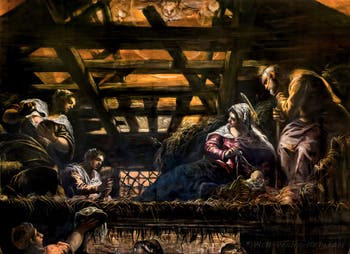
The Adoration of the Shepherds Meanwhile, the visiting shepherds joyfully unwrap their gifts, which they pass on to the two women above them, piously kneeling before the Virgin who unveils the child to them.
Below, the natural light streaming in through the entrance highlights the beautiful colours of the cockerel and peacock, as well as those of the shepherds' lively clothes.
Above, supernatural light falls directly from the sky through the roof beams onto Marie and her baby, onto the face of Joseph seated next to Marie, and onto the two young women with lowered eyelids.
Through daring superimposition, this magnificent work illustrates an exceptional and incredible event: the birth of the divine child in the utmost simplicity.
Tintoretto “The Temptation of Christ”
Oil on Canvas (539 x 330 cm) 1578-1581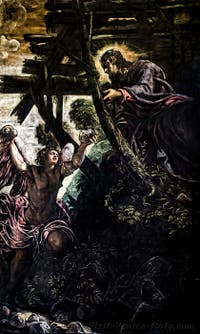
The Temptation of Christ Tintoretto has chosen to show the devil's first attempt to divert the Christ from his mission as a man of God:
After his baptism, Jesus had withdrawn into the desert, just as Moses had stayed forty days and forty nights on the mountain.
“And after fasting forty days and forty nights, at last he was hungry.
And coming forward, the tempter said to him, “If you are the son of God, say that these stones become loaves of bread.”
Answering, he said: ”It is written that man shall not live by bread alone, but by every word that proceeds from the mouth of God.”
Gospels: Luke 4 - Matthew 4
The scene depicts Jesus at the top right of the painting, seated under a plank shelter, bending to the left to respond to the tender-faced demon who is looking at him so kindly and handing him two beautiful stones, round as loaves of bread.
He offers his stones as an innocent child would to a magician.
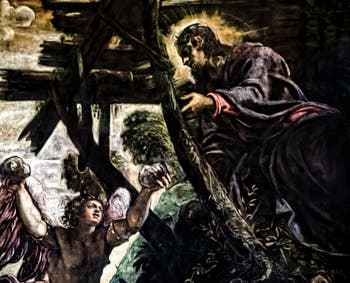
The Temptation of Christ The emaciated face surrounded by light and the serene attitude of Jesus, illustrate both his physical fatigue and his spiritual strength in the face of temptation.
Temptation offered by this beautiful hermaphrodite with biceps adorned with bracelets and whose garment, matching his pink wings, now covers only his hips and thighs.
The devil's malice invents every trick in the book to exploit the slightest weakness, as soon as it becomes apparent.
Evil can disguise itself as solicitude.
Yet it was the miracles performed by Jesus that had convinced the crowds who followed him, and who saw in him God's Chosen One capable of relieving them of all evils.
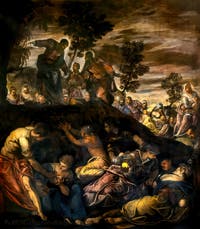
The Multiplication of Bread
Tintoretto “The Multiplication of Breads and Fish”
Oil on Canvas (523 x 475 cm) 1578-1581Gospels according to: John 6, v. 1-13. And: Mark 6, v. 31-34. Luke 9, v. 10-17. Matt. 14, v. 15-21.
At the bottom of the painting, the exhausted and starving bodies of the many faithful who follow Jesus like a flock follows its shepherd.
To their right, at the foot of the hill, a pitying man (Tintoretto?) watches them.
From here he guides us along the dark line of the hill; and we see nursing women among the colourful crowd of confident worshippers.
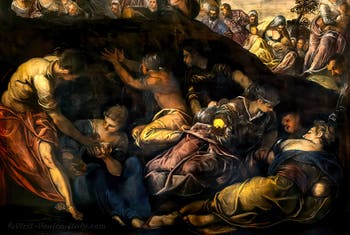
The Multiplication of Bread and Fish Everyone waits calmly under the light until they reach the top, where Jesus and his disciples are.
Two of them are deep in conversation, no doubt the ones who advised Jesus to send these people away to buy their food in the nearby villages!
Between Jesus and Andrew, the young man with the basket containing the five loaves and two fish that will miraculously satiate a crowd of five thousand people.
The Multiplication of the Loaves is undoubtedly a model of sharing and charity for the members of the Confraternity of San Rocco.
History Art Scuola | Rivalries | Crucifixion | Pilate Ecce Homo Calvary | Official Painter | Snake | Moses Manna | Sin Isaac Jacob | Adoration Temptation Breads | Probatic Pool Last Supper | Olive Garden Resurrection | Pianta | Annunciation Adoration Flight | Innocents Circumcision
San Rocco History Art | Location | Opening Hours Tickets | Authorizations
Museums Doge's Palace | Guggenheim | Correr | Pesaro | Rezzonico | Murano | Accademia | Oriental | Ca d'Oro | Archeological | Querini | Bovolo | Pisani | Fortuny | Rocco | Lace | Marciana | Grassi | Dogana
Back to Top of Page

